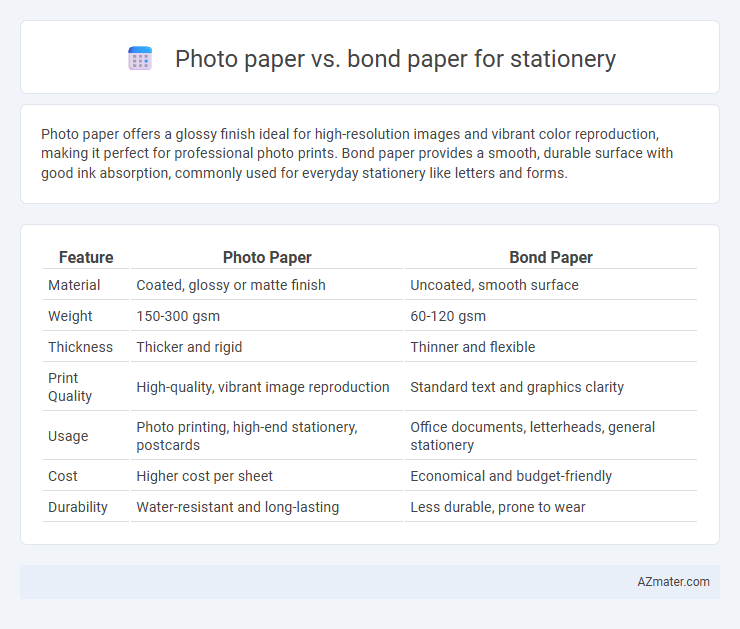Photo paper offers a glossy finish ideal for high-resolution images and vibrant color reproduction, making it perfect for professional photo prints. Bond paper provides a smooth, durable surface with good ink absorption, commonly used for everyday stationery like letters and forms.
Table of Comparison
| Feature | Photo Paper | Bond Paper |
|---|---|---|
| Material | Coated, glossy or matte finish | Uncoated, smooth surface |
| Weight | 150-300 gsm | 60-120 gsm |
| Thickness | Thicker and rigid | Thinner and flexible |
| Print Quality | High-quality, vibrant image reproduction | Standard text and graphics clarity |
| Usage | Photo printing, high-end stationery, postcards | Office documents, letterheads, general stationery |
| Cost | Higher cost per sheet | Economical and budget-friendly |
| Durability | Water-resistant and long-lasting | Less durable, prone to wear |
Introduction to Photo Paper and Bond Paper
Photo paper is a specialized paper coated with light-sensitive chemicals, designed to produce high-quality, glossy prints ideal for photographs and professional images. Bond paper, commonly used in offices, is a durable, uncoated or lightly coated paper made from rag pulp or wood pulp, intended primarily for writing, printing, and general stationery purposes. Understanding the distinct textures and finishes of photo paper versus bond paper helps determine their appropriate applications in stationery and printing environments.
Key Differences Between Photo Paper and Bond Paper
Photo paper features a glossy or matte finish designed to enhance image quality and color vibrancy, making it ideal for printing photographs and high-resolution images. Bond paper, typically smooth and durable with a weight range of 50 to 120 gsm, is primarily used for everyday printing, writing, and office documents due to its affordability and versatility. The key differences lie in texture, finish, weight, and intended use, with photo paper optimized for photo clarity and bond paper suited for text-heavy documents.
Texture and Finish Comparison
Photo paper features a glossy or satin finish with a smooth texture that enhances color vibrancy and sharp image detail, making it ideal for high-quality photo printing. Bond paper has a matte or lightly textured surface that provides a more tactile, professional feel, suited for documents, letters, and everyday printing. The contrast in finish affects print clarity and durability, with photo paper offering a sleek, reflective appearance versus bond paper's subdued and absorbent texture.
Print Quality: Photo Paper vs Bond Paper
Photo paper offers superior print quality with high gloss or matte finishes that enhance color vibrancy and sharpness, making it ideal for photographs and professional presentations. Bond paper, commonly used for everyday printing and stationery, delivers adequate print quality but lacks the rich color depth and detail reproduction seen in photo paper. For projects requiring vivid image clarity and durable prints, photo paper is the preferred choice over bond paper.
Durability and Longevity Factors
Photo paper offers superior durability and resistance to fading due to its specialized coatings that protect against moisture, fingerprints, and UV light, making it ideal for preserving images and important documents. Bond paper, while less resistant to physical wear and environmental exposure, provides decent longevity for everyday printing and writing tasks due to its sturdy cellulose fibers and smooth surface. For stationery requiring long-term durability, photo paper is preferred, especially in archival or display contexts, whereas bond paper suits general office use where cost-effectiveness and moderate durability suffice.
Best Uses for Photo Paper in Stationery
Photo paper excels in stationery applications requiring high-quality, vibrant image reproduction, such as personalized invitations, greeting cards, and custom postcards, due to its glossy finish and enhanced color accuracy. Its thick, durable texture ensures a professional appearance and longevity, ideal for keepsake stationery or special event prints. Unlike bond paper, which is suited for everyday printing and writing tasks, photo paper enhances visual impact and detail, making it the preferred choice for visually striking stationery items.
Ideal Applications for Bond Paper
Bond paper is ideal for everyday office and school stationery such as letterheads, envelopes, and forms due to its durability and smooth finish that supports high-quality printing. It is commonly used for official documents, legal paperwork, and professional correspondence, providing a clean and professional appearance. Its affordability and strength make it suitable for frequent handling and copying, distinguishing it from photo paper, which is designed mainly for high-resolution image printing.
Cost Analysis: Photo Paper vs Bond Paper
Photo paper generally incurs higher costs due to its specialized coating and glossy finish, making it more expensive per sheet compared to bond paper. Bond paper, widely used for everyday printing and office documents, offers a more economical choice with lower production costs and bulk availability. For budget-conscious stationery needs, bond paper provides a cost-effective solution without sacrificing print quality for standard text and graphics.
Environmental Impact and Sustainability
Photo paper typically contains a plastic coating that hinders its recyclability and contributes to increased environmental pollution, whereas bond paper is generally uncoated and easier to recycle, reducing landfill waste. The production of photo paper involves higher energy consumption and chemical usage due to glossy finishes and ink absorption layers, resulting in a larger carbon footprint compared to bond paper. Opting for recycled bond paper or sustainably sourced paper products significantly minimizes deforestation and supports eco-friendly stationery practices.
How to Choose the Right Paper for Your Stationery
Selecting the right paper for stationery depends on purpose and desired quality; photo paper offers high-gloss finish ideal for vibrant images and professional invitations, while bond paper provides durability and smooth texture suited for everyday correspondence and official documents. Consider weight, finish, and ink absorption--photo paper enhances color brilliance but can be prone to smudging, whereas bond paper supports easy writing and reduces ink bleed. Matching paper type to printing technology and usage ensures optimal presentation, longevity, and user experience in stationery applications.

Infographic: Photo paper vs Bond paper for Stationery
 azmater.com
azmater.com